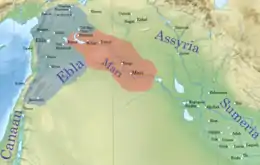Iblul-Il
Iblul-Il (reigned c. 2380 BC),[2] was the most energetic king (Lugal) of the second Mariote kingdom, noted for his extensive campaigns in the middle Euphrates valley against the Eblaites, and in the upper Tigris region against various opponents, which asserted the Mariote supremacy in the Syrian north.
| Iblul-Il | |
|---|---|
| King of Mari | |
| Tenure | c. 2380 BC. Middle chronology |
| Predecessor | Išhtup-Išar |
| Successor | Nizi |
| King of Mari | |
| Wife | Paba[1] |
Reign
Sources
Iblul-Il is attested in Mari, where statues bearing his name were excavated in 1952 from the city's temples.[3] However, the deeds of the king are recorded in a letter sent to Ebla by Enna-Dagan, a successor of Iblul-Il.[4]
Campaigns

Iblul-Il campaigned extensively against Ebla and its vassals and allies.[4] The offensive was probably due to Ebla's increasing militaristic character, and was meant to block the trade route between Kish, Nagar and Ebla.[5] Iblul-Il was a contemporary of Ebla's king Igrish-Halam,[5] and is mentioned in the letter of Enna-Dagan campaigning in the middle Euphrates defeating the city of Galalaneni,[6] and engaging in a victorious battle with Abarsal in the region of Zahiran,[note 1][8] which he destroyed.[6] Next, Iblul-Il campaigned in the region of Burman of the land of Sugurum, where he defeated the cities of Shadab, Addalini and Arisum.[6] The campaigns continued as the king sacked the cities of Sharan and Dammium,[6] and advanced on Neraad and Hasuwan, receiving the tribute from Ebla at the city of Mane,[9] and from the fortress Khazuwan, then continued his march and conquered Emar.[6]
In the Tigris valley, Iblul-Il defeated the cities of Nahal, Nubat and Sha-da from the region of Gasur, at a battle in the land of Ganane.[note 2][10] Iblul-Il is finally mentioned in the letter conquering the Eblaite cities of Barama, Aburu, Tibalat and Belan.[note 3][6] The Mariote king successfully achieved his goals and weakened Ebla, exacting a great amount of tribute in the form of gold and silver.[5]
Succession
Iblul-Il was succeeded by Nizi.[13] The letter of Enna-Dagan is extremely difficult to read,[14] and early decipherment presented the author as a general of Ebla who defeated and deposed Iblul-Il.[15] However, newer readings confirmed Enna-Dagan as a king from Mari,[6] and further decipherment of the archives of Ebla showed Enna-Dagan receiving gifts from Ebla as a prince of Mari during the reigns of his Mariote predecessors.[16][17]
King Iblul-Il of Mari | ||
| Regnal titles | ||
|---|---|---|
| Preceded by Išhtup-Išar |
King of Mari 2380 BC |
Succeeded by Nizi |
See also
Notes
- Abarsal is probably located along the Euphrates river east of Ebla.[7]
- According to Michael Astour, those three cities belonged to the region named Gasur-Nuzi in the northern Tigris area.[10] However, other scholars such as Marco Bonechi place Gasur in the middle Euphrates valley to the northwest of Mari.[11]
- Belan is located 26 km west of Raqqa.[12]
Citations
- Pelio Fronzaroli (2003). Semitic and Assyriological Studies: Presented to Pelio Fronzaroli by Pupils and Colleagues (in Italian). p. 556. ISBN 9783447047494.
- William J. Hamblin (2006). Warfare in the Ancient Near East to 1600 BC. p. 242. ISBN 9781134520626.
- Chaim Bermant; Michael Weitzman (1979). Ebla: a revelation in archeology. Times Books. p. 173. ISBN 9780812907650.
- I. Tzvi Abusch; Carol Noyes; William W. Hallo; Irene Winter (2001). Proceedings of the XLV Rencontre Assyriologique Internationale: Historiography in the Cuneiform World, Part 1. p. 1. ISBN 9781883053673.
- Nadali, Davide (2007). "Monuments of War, War of Monuments: Some Considerations on Commemorating War in the Third Millennium BC". Orientalia. Davide Nadali: 350. Retrieved 24 April 2015.
- Mario Liverani (2013). The Ancient Near East: History, Society and Economy. p. 119. ISBN 9781134750849.
- Archi, Alfonso (2011). "Alfonso Archi and Maria Giovanna Biga, In Search of Armi". Journal of Cuneiform Studies. The American Schools of Oriental Research. 63: 5–34. doi:10.5615/jcunestud.63.0005. JSTOR 10.5615/jcunestud.63.0005. S2CID 163552750.
- Edgar Peltenberg (2007). Euphrates River Valley Settlement: The Carchemish Sector in the Third Millennium BC. p. 118. ISBN 9781782975113.
- Joan Aruz,Ronald Wallenfels (2003). Art of the First Cities: The Third Millennium B.C. p. 462.
- Martha A. Morrison; David I. Owen (1987). General Studies and Excavations at Nuzi 9/1. p. 13. ISBN 9780931464089.
- Lluís Feliu (2003). The God Dagan in Bronze Age Syria. p. 23. ISBN 978-9004131583.
- P.M. Michèle Daviau; Michael Weigl; John W. Wevers (2001). The World of the Aramaeans: Studies in Honour of Paul-Eugène Dion, Volume 1. p. 233. ISBN 9780567200495.
- Douglas Frayne (2008). Pre-Sargonic Period: Early Periods, Volume 1 (2700-2350 BC). p. 815. ISBN 9781442690479.
- Martha A. Morrison; David I. Owen (1987). General Studies and Excavations at Nuzi 9/1. p. 12. ISBN 9780931464089.
- Victor Harold Matthews, Don C. Benjamin (2006). Old Testament Parallels: Laws and Stories from the Ancient Near East. p. 261. ISBN 9780809144358.
- Douglas Frayne (2008). Pre-Sargonic Period: Early Periods, Volume 1 (2700-2350 BC). p. 778. ISBN 9781442690479.
- Douglas Frayne (2008). Pre-Sargonic Period: Early Periods, Volume 1 (2700-2350 BC). p. 817. ISBN 9781442690479.
Further reading
- Bonechi, Marco (1998). "Remarks on the III Millennium Geographical Names of the Syrian Upper Mesopotamia". In Lebeau, Marc (ed.). About Subartu. Studies Devoted to Upper Mesopotamia. Volume I: Landscape, Archeology, Settlement. Volume II: Culture, society, Image. Subartu (SUBART). 4. Brepols Publishers. ISBN 978-2-503-50652-4.